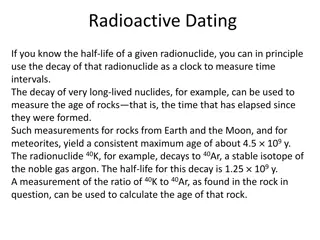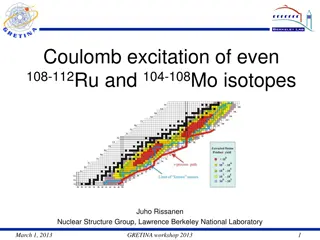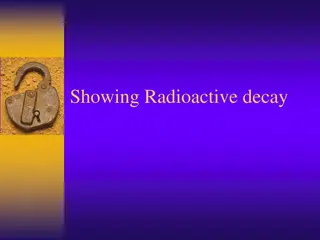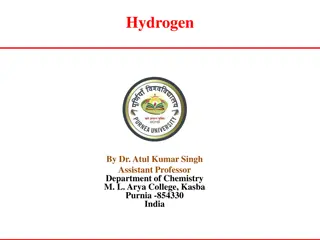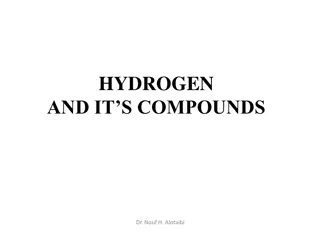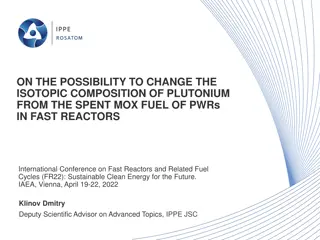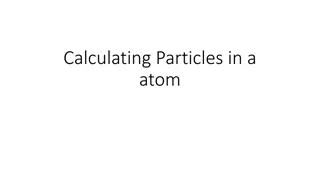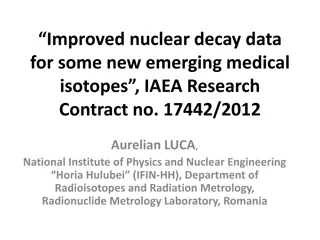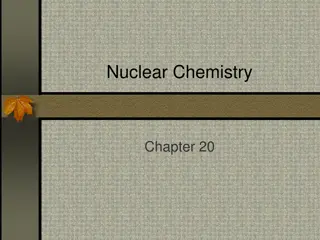Understanding Isotopes in Biogeochemistry
Isotopes are atoms with the same number of protons but different numbers of neutrons. This presentation explores the significance of stable isotopes, types of isotopes, expressing isotopic abundances, isotope effects, and applications to geochemical studies. Learn about common light element stable isotopes and how to express isotopic compositions using delta notation. Dive into isotopic-mass balance calculations and their role in understanding biogeochemical processes in various systems.
Download Presentation

Please find below an Image/Link to download the presentation.
The content on the website is provided AS IS for your information and personal use only. It may not be sold, licensed, or shared on other websites without obtaining consent from the author. Download presentation by click this link. If you encounter any issues during the download, it is possible that the publisher has removed the file from their server.
E N D
Presentation Transcript
Biogeochemistry I Introduction to Isotopes Prosper Zigah Woods Hole Oceanographic Institution pzigah@whoi.edu 1
Biogeochemistry I: Isotope biogeochemistry Biogeochemistry I: Isotope biogeochemistry 1. What are Isotopes 2. Why care about stable isotopes? 3. Expressing Isotopic abundances 4. Isotope effects 5. Isotopic-mass balance calculations (two-component and multiple- component mixing models) 6. Applications to geochemical studies of the ocean and a lacustrine system Presentation on
What are Isotopes: What are Isotopes: Isotopes are atoms with the same number of protons but different number of neutrons E.g. Isotopes of carbon: 12C (6 protons and 6 neutrons) 13C (6 protons and 7 neutrons) 14C (6 protons and 8 neutrons)
Types of Isotopes: Types of Isotopes: Stable isotopes: Do not decay radioactively 12C , 13C 1H, 2H Radio-isotopes : Unstable and decay radioactively 14C 3H
Common Light Element Stable Isotopes Common Light Element Stable Isotopes
Expressing Isotopic compositions Expressing Isotopic compositions Absolute abundances Atom percent: For eg. Atom percent 13C = [13C/13C+12C]* 100 Fractional abundance: fractional abundance of 13C 13F = [13C/13C+12C] Isotope ratios Generally reported as the ratio of a rare isotope to a more abundant isotope. E.g. carbon isotope ratio = 13R = 13C/12C For dual isotopic elements (with only 2 stable nuclides, e.g. C, H and N), there is a pretty straightforward relationship between F and R 13R = 13F / (1 13F) 13F = 13R / (1 + 13R) For multi-isotopic elements eg. oxygen 18R = 18F / (1 17F - 18F) 18F = 18R / (1 + 17R + 18R)
Delta notation Delta notation Urey 1948 and McKinney et al. 1950 Isotope ratio standards expresses the isotope ratio relative to a standard = [Rsample/Rstandard 1]*1000 Rsample is the isotope ratio of the sample Rstandard is the isotope ratio of a standard or reference material (permil or per mille)
Isotopic Isotopic- -mass balance calculations mass balance calculations 1. Isotopic composition of pooled samples * m = m1* 1 + m2* 2 + m2* 2+ where m is the molar concentrations of the element of interest is the isotopic ratios Example 1. A closed-system Lake Brian with dissolved inorganic carbon concentration [DIC] of 800 mol C/L is fed by Lester, Ontonagon, and Brule rivers with DIC- 13C of 0.6 ,1.8 and -0.5 , respectively. What is the 13C of the Lake DIC if the proportional contributions of Lester, Ontonagon, and Brule rivers to the lake DIC are 20%, 35% and 45%. Example 2. The particulate organic matter (POM) in the coastal waters off Tema harbor has 13C of -25 , and derives primarily from terrigenous organic carbon with 13C of -28 and in situ algae with 13C of -21 . Using two-component mixing model and accounting for isotopic mass balance and conservation of mass, calculate the proportion of terrigenous and algal carbon in the POM.
Isotopic Isotopic- -mass balance calculations mass balance calculations 2. Isotope dilution analyses * m = msample* sample + mspike* spike where = measured isotopic value of sample plus spike m = Combined mass of sample and spike msample , mspike = mass of sample and spike, respectively sample , spike = Isotopic value of sample and spike, respectively 3. Blank corrections * m = ms* s + mb* b Substituting ms = m mb, and rearranging gives = s mb ( s - b) / m yielding an equation of the form y = a + bx Plotting vs. 1/ m will give the blank-corrected accurate s value as the y intercept.
Stable Isotope mixing models Stable Isotope mixing models 1. IsoSource Model IsoSource calculates ranges of source proportional contributions to a mixture based on stable isotope analyses when the number of sources is too large to permit a unique solution (> number of isotope systems + 1). The user supplies the isotopic signatures for the mixture and each of the sources. 2. MixSIR Model MixSIR is a Bayesian isotopic modeling tool for partitioning the proportional contributions of potential sources to the bulk POC based on their 13C and 15N signatures. The MixSIR model works by determining probability distributions of sources contributing to the observed mixed signal while accounting explicitly for the uncertainty in the isotopic signatures of the sources and fractionation.
Measuring Isotopic Ratios Measuring Isotopic Ratios Convert the element into a stable gas Clean/purify the gas from contaminants (online or offline) Measure the isotopic ratios using Isotope ratio mass spectrometer (IRMS)
Measuring Isotopic Ratios Measuring Isotopic Ratios Carbon isotope ratio of dissolved organic carbon (DOC) Simultaneous measurement of carbon and nitrogen Isotopic ratio of particulate organic matter (POM)/zooplankton/fish muscle - Acidify to pH 2 and spurge to remove inorganic carbon/carbonate - UV-Oxidize the organic carbon in the water to CO2 - Trap and purify the CO2 on a vacuum line (trap the CO2 with liquid N2 and flush out the incondensables) Flash combust material at 1200 oC to CO2 and NO2. Split the gas stream One stream into a packed oxidation column to ensure complete oxidation to CO2 and into IRMS 44 (12C-16O-16O) - CO2 into IRMS and measure m/z 44 (12C-16O-16O) 45 (12C-16O-16O; 12C-17O-16O ; 12C-16O-17O) 45 (12C-16O-16O; 12C-17O-16O ; 12C-16O-17O) 46 (12C-18O-16O; 12C-16O-18O) Other split into a reduction column to reduce the NO2 to N2 and into the IRMS Carbon isotope ratio of carbonate CaCO3 + acid = CO2 28 (14N-14N) CO2 into IRMS and measure m/z 44 (12C-16O-16O) 29 (15N-14N) 45 (12C-16O-16O; 12C-17O-16O ; 12C-16O-17O) 46 (12C-18O-16O; 12C-16O-18O)
Isotope ratio mass spectrometer (IRMS) Isotope ratio mass spectrometer (IRMS) Source: www.boundless.com
Isotopic fractionation Isotopic fractionation 2. Equilibrium isotope fractionation 1. Kinetic isotope fractionation The reaction and transport rates of one isotope is faster than the other Reaction in which a single atom is exchanged between two species Could be caused by chemical, biological or physical processes Distribution is determined by thermodynamics rather than kinetics Eg. 1 Photosynthesis CO2 ( 13C = -8 ) to organic carbon ( 13C = -28 ) Eg. 1




